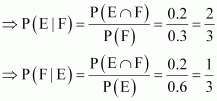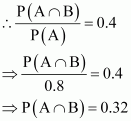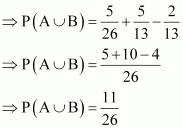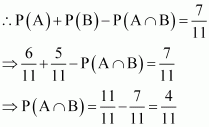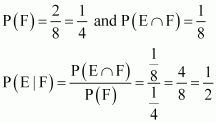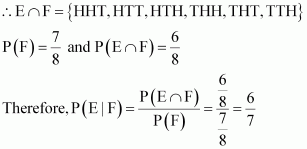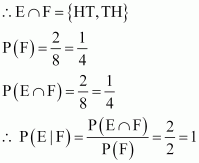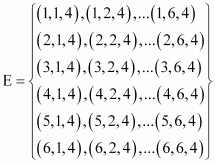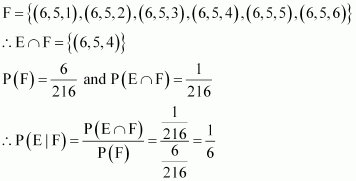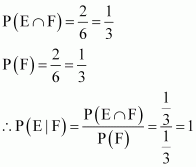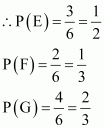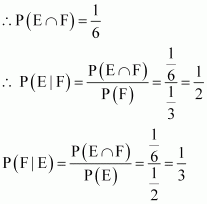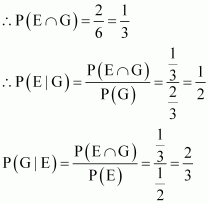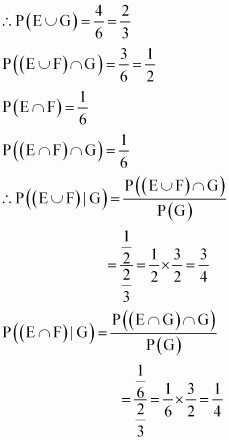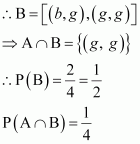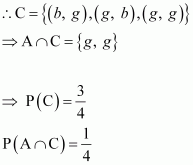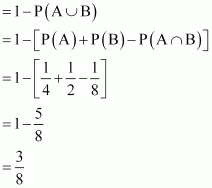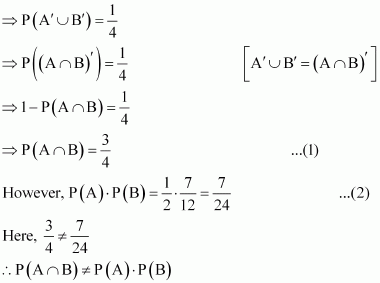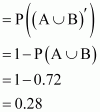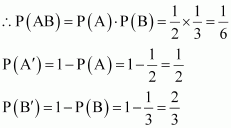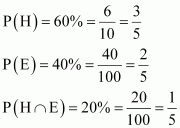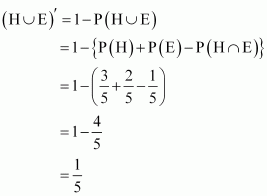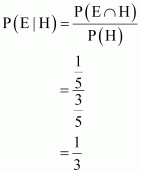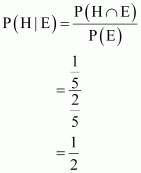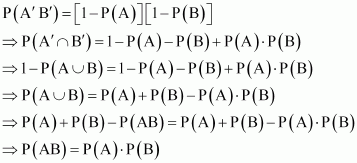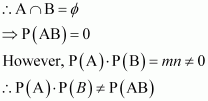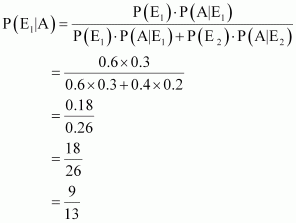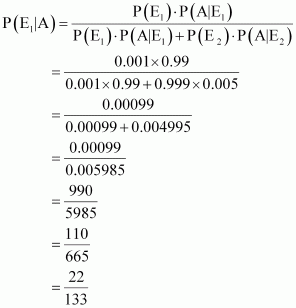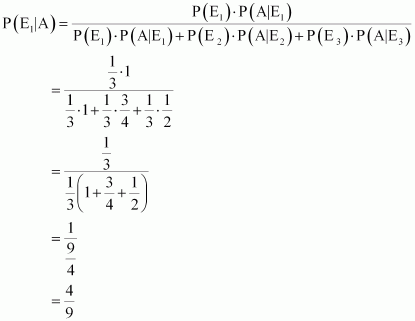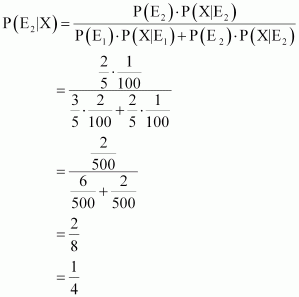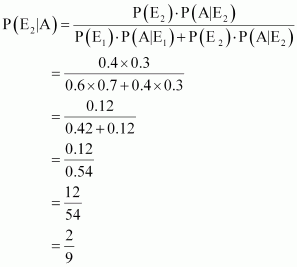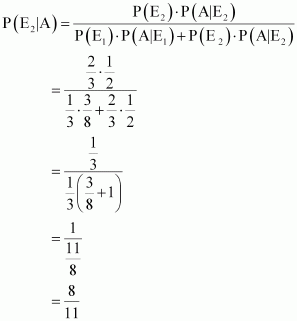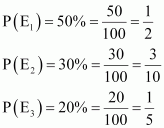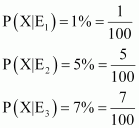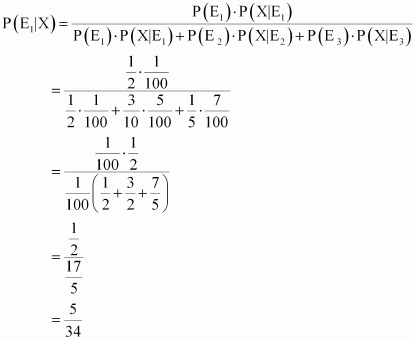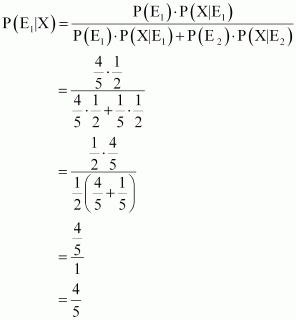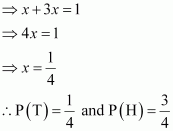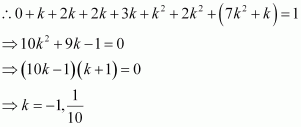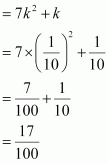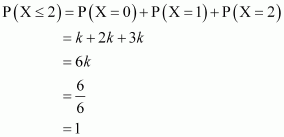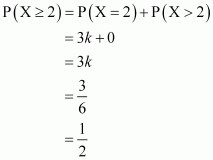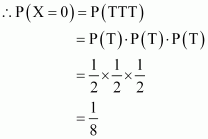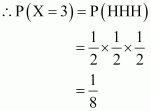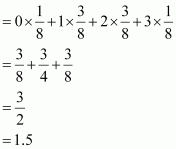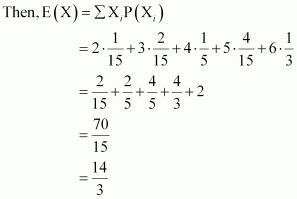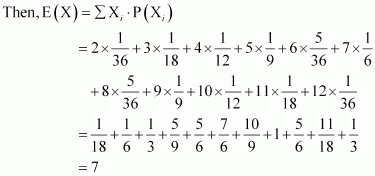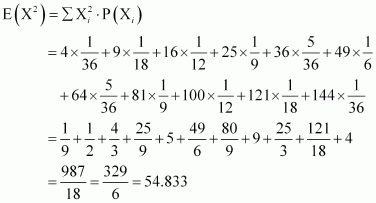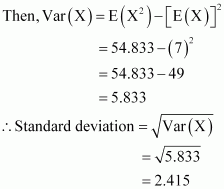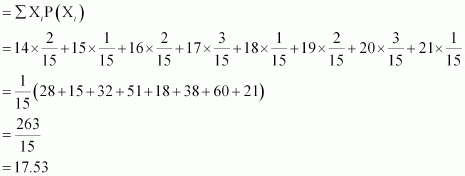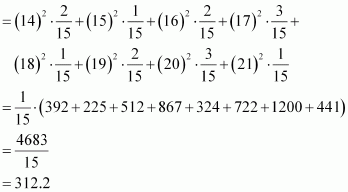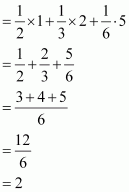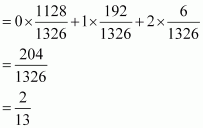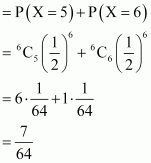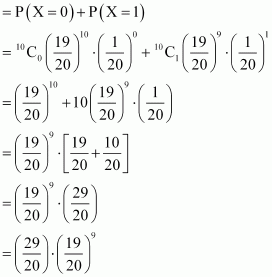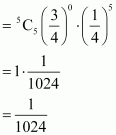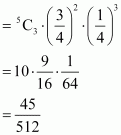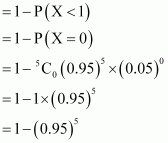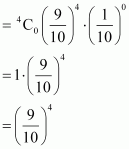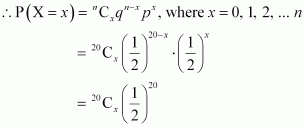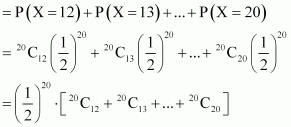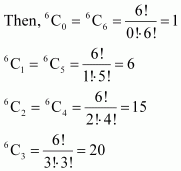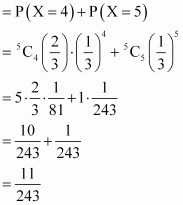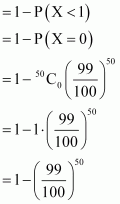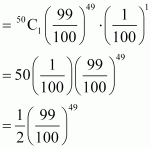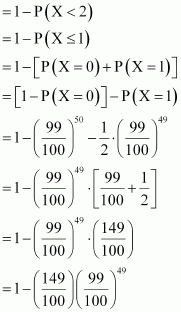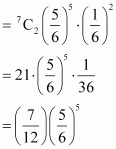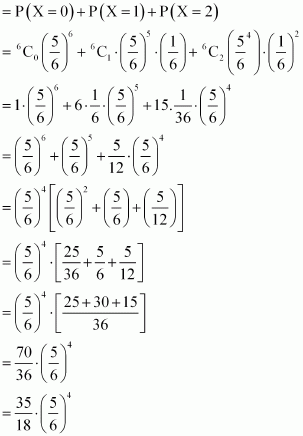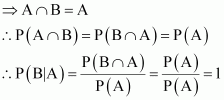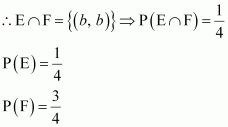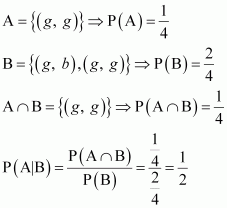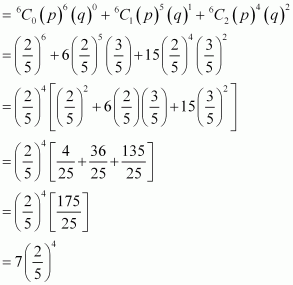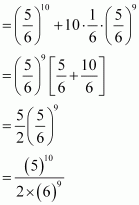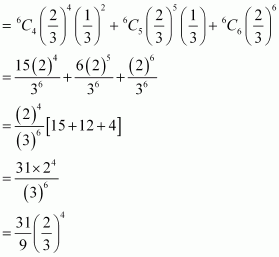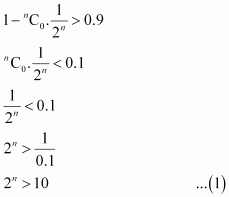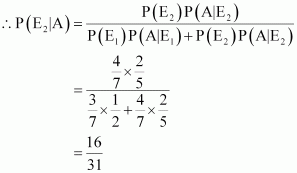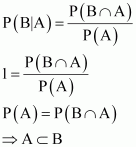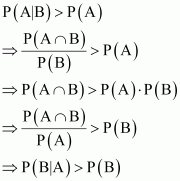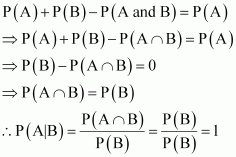Page No 538:
Question 1:
Given that E and F are events such that P(E) = 0.6, P(F) = 0.3 and P(E ∩ F) = 0.2, find P (E|F) and P(F|E).
Answer:
It is given that P(E) = 0.6, P(F) = 0.3, and P(E ∩ F) = 0.2
Question 2:
Compute P(A|B), if P(B) = 0.5 and P (A ∩ B) = 0.32
Answer:
It is given that P(B) = 0.5 and P(A ∩ B) = 0.32
Question 3:
If P(A) = 0.8, P(B) = 0.5 and P(B|A) = 0.4, find
(i) P(A ∩ B) (ii) P(A|B) (iii) P(A ∪ B)
Answer:
It is given that P(A) = 0.8, P(B) = 0.5, and P(B|A) = 0.4
(i) P (B|A) = 0.4
(ii)
(iii)
PA∪B = PA + PB – PA∩B⇒PA∪B=0.8 + 0.5 – 0.32 = 0.98
Question 4:
Evaluate P (A ∪ B), if 2P (A) = P (B) =and P(A|B) =
Answer:
It is given that,
It is known that,
Question 5:
If P(A), P(B) =
and P(A ∪ B) =
, find
(i) P(A ∩ B) (ii) P(A|B) (iii) P(B|A)
Answer:
It is given that
(i)
(ii) It is known that,
(iii) It is known that,
Question 6:
A coin is tossed three times, where
(i) E: head on third toss, F: heads on first two tosses
(ii) E: at least two heads, F: at most two heads
(iii) E: at most two tails, F: at least one tail
Answer:
If a coin is tossed three times, then the sample space S is
S = {HHH, HHT, HTH, HTT, THH, THT, TTH, TTT}
It can be seen that the sample space has 8 elements.
(i) E = {HHH, HTH, THH, TTH}
F = {HHH, HHT}
E ∩ F = {HHH}
(ii) E = {HHH, HHT, HTH, THH}
F = {HHT, HTH, HTT, THH, THT, TTH, TTT}
E ∩ F = {HHT, HTH, THH}
Clearly,
(iii) E = {HHH, HHT, HTT, HTH, THH, THT, TTH}
F = {HHT, HTT, HTH, THH, THT, TTH, TTT}
Page No 539:
Question 7:
Two coins are tossed once, where
(i) E: tail appears on one coin, F: one coin shows head
(ii) E: not tail appears, F: no head appears
Answer:
If two coins are tossed once, then the sample space S is
S = {HH, HT, TH, TT}
(i) E = {HT, TH}
F = {HT, TH}
(ii) E = {HH}
F = {TT}
∴ E ∩ F = Φ
P (F) = 1 and P (E ∩ F) = 0
∴ P(E|F) =
Question 8:
A die is thrown three times,
E: 4 appears on the third toss, F: 6 and 5 appears respectively on first two tosses
Answer:
If a die is thrown three times, then the number of elements in the sample space will be 6 × 6 × 6 = 216
Question 9:
Mother, father and son line up at random for a family picture
E: son on one end, F: father in middle
Answer:
If mother (M), father (F), and son (S) line up for the family picture, then the sample space will be
S = {MFS, MSF, FMS, FSM, SMF, SFM}
⇒ E = {MFS, FMS, SMF, SFM}
F = {MFS, SFM}
∴ E ∩ F = {MFS, SFM}
Question 10:
A black and a red dice are rolled.
(a) Find the conditional probability of obtaining a sum greater than 9, given that the black die resulted in a 5.
(b) Find the conditional probability of obtaining the sum 8, given that the red die resulted in a number less than 4.
Answer:
Let the first observation be from the black die and second from the red die.
When two dice (one black and another red) are rolled, the sample space S has 6 × 6 = 36 number of elements.
- Let
A: Obtaining a sum greater than 9
= {(4, 6), (5, 5), (5, 6), (6, 4), (6, 5), (6, 6)}
B: Black die results in a 5.
= {(5, 1), (5, 2), (5, 3), (5, 4), (5, 5), (5, 6)}
∴ A ∩ B = {(5, 5), (5, 6)}
The conditional probability of obtaining a sum greater than 9, given that the black die resulted in a 5, is given by P (A|B).
PA|B = PA∩BPB = 236636 = 26 = 13
(b) E: Sum of the observations is 8.
= {(2, 6), (3, 5), (4, 4), (5, 3), (6, 2)}
F: Red die resulted in a number less than 4.
The conditional probability of obtaining the sum equal to 8, given that the red die resulted in a number less than 4, is given by P (E|F).
Question 11:
A fair die is rolled. Consider events E = {1, 3, 5}, F = {2, 3} and G = {2, 3, 4, 5}
Find
(i) P (E|F) and P (F|E) (ii) P (E|G) and P (G|E)
(ii) P ((E ∪ F)|G) and P ((E ∩ G)|G)
Answer:
When a fair die is rolled, the sample space S will be
S = {1, 2, 3, 4, 5, 6}
It is given that E = {1, 3, 5}, F = {2, 3}, and G = {2, 3, 4, 5}
(i) E ∩ F = {3}
(ii) E ∩ G = {3, 5}
(iii) E ∪ F = {1, 2, 3, 5}
(E ∪ F) ∩ G = {1, 2, 3, 5} ∩{2, 3, 4, 5} = {2, 3, 5}
E ∩ F = {3}
(E ∩ F) ∩ G = {3}∩{2, 3, 4, 5} = {3}
Question 12:
Assume that each born child is equally likely to be a boy or a girl. If a family has two children, what is the conditional probability that both are girls given that (i) the youngest is a girl, (ii) at least one is a girl?
Answer:
Let b and g represent the boy and the girl child respectively. If a family has two children, the sample space will be
S = {(b, b), (b, g), (g, b), (g, g)}
Let A be the event that both children are girls.
(i) Let B be the event that the youngest child is a girl.
The conditional probability that both are girls, given that the youngest child is a girl, is given by P (A|B).
Therefore, the required probability is.
(ii) Let C be the event that at least one child is a girl.
The conditional probability that both are girls, given that at least one child is a girl, is given by P(A|C).
Question 13:
An instructor has a question bank consisting of 300 easy True/False questions, 200 difficult True/False questions, 500 easy multiple choice questions and 400 difficult multiple choice questions. If a question is selected at random from the question bank, what is the probability that it will be an easy question given that it is a multiple choice question?
Answer:
The given data can be tabulated as
| True/False | Multiple choice | Total | |
| Easy | 300 | 500 | 800 |
| Difficult | 200 | 400 | 600 |
| Total | 500 | 900 | 1400 |
Let us denote E = easy questions, M = multiple choice questions, D = difficult questions, and T = True/False questions
Total number of questions = 1400
Total number of multiple choice questions = 900
Therefore, probability of selecting an easy multiple choice question is
P (E ∩ M) =
Probability of selecting a multiple choice question, P (M), is
P (E|M) represents the probability that a randomly selected question will be an easy question, given that it is a multiple choice question.
∴
Therefore, the required probability is.
Question 14:
Given that the two numbers appearing on throwing the two dice are different. Find the probability of the event ‘the sum of numbers on the dice is 4’.
Answer:
When dice is thrown, number of observations in the sample space = 6 × 6 = 36
Let A be the event that the sum of the numbers on the dice is 4 and B be the event that the two numbers appearing on throwing the two dice are different. ∴ A = {(1, 3), (2, 2), (3, 1)}
B=1, 21, 31, 41, 51, 62, 12, 32, 42, 52, 63, 13, 23, 43, 53, 64, 14, 24, 34, 54, 65, 15, 25, 35, 45,66, 16, 26, 36, 46, 5 A∩B = 1, 3, 3, 1∴ P(B) =
3036=56and
PA∩B = 236=118Let P (A|B) represent the probability that the sum of the numbers on the dice is 4, given that the two numbers appearing on throwing the two dice are different.

.
Question 15:
Consider the experiment of throwing a die, if a multiple of 3 comes up, throw the die again and if any other number comes, toss a coin. Find the conditional probability of the event ‘the coin shows a tail’, given that ‘at least one die shows a 3’.
Answer:
The outcomes of the given experiment can be represented by the following tree diagram.
The sample space of the experiment is,
Let A be the event that the coin shows a tail and B be the event that at least one die shows 3.
Probability of the event that the coin shows a tail, given that at least one die shows 3, is given by P(A|B).
Therefore,
Question 16:
If
(A) 0 (B)
(C) not defined (D) 1
Answer:
It is given that
Therefore, P (A|B) is not defined.
Thus, the correct answer is C.
Page No 540:
Question 17:
If A and B are events such that P (A|B) = P(B|A), then
(A) A ⊂ B but A ≠ B (B) A = B
(C) A ∩ B = Φ (D) P(A) = P(B)
Answer:
It is given that, P(A|B) = P(B|A)
⇒ P (A) = P (B)
Thus, the correct answer is D.
Page No 546:
Question 1:
If, find P (A ∩ B) if A and B are independent events.
Answer:
It is given that
A and B are independent events. Therefore,
Question 2:
Two cards are drawn at random and without replacement from a pack of 52 playing cards. Find the probability that both the cards are black.
Answer:
There are 26 black cards in a deck of 52 cards.
Let P (A) be the probability of getting a black card in the first draw.
Let P (B) be the probability of getting a black card on the second draw.
Since the card is not replaced,
Thus, probability of getting both the cards black =
Question 3:
A box of oranges is inspected by examining three randomly selected oranges drawn without replacement. If all the three oranges are good, the box is approved for sale, otherwise, it is rejected. Find the probability that a box containing 15 oranges out of which 12 are good and 3 are bad ones will be approved for sale.
Answer:
Let A, B, and C be the respective events that the first, second, and third drawn orange is good.
Therefore, probability that first drawn orange is good, P (A)
The oranges are not replaced.
Therefore, probability of getting second orange good, P (B) =
Similarly, probability of getting third orange good, P(C)
The box is approved for sale, if all the three oranges are good.
Thus, probability of getting all the oranges good
Therefore, the probability that the box is approved for sale is .
Question 4:
A fair coin and an unbiased die are tossed. Let A be the event ‘head appears on the coin’ and B be the event ‘3 on the die’. Check whether A and B are independent events or not.
Answer:
If a fair coin and an unbiased die are tossed, then the sample space S is given by,
Let A: Head appears on the coin
B: 3 on die
∴
Therefore, A and B are independent events.
Question 5:
A die marked 1, 2, 3 in red and 4, 5, 6 in green is tossed. Let A be the event, ‘the number is even,’ and B be the event, ‘the number is red’. Are A and B independent?
Answer:
When a die is thrown, the sample space (S) is
S = {1, 2, 3, 4, 5, 6}
Let A: the number is even = {2, 4, 6}
⇒
B: the number is red = {1, 2, 3}
⇒
PB =36=12∴ A ∩ B = {2}
Therefore, A and B are not independent.
Question 6:
Let E and F be events with. Are E and F independent?
Answer:
It is given that, and
Therefore, E and F are not independent.
Page No 547:
Question 7:
Given that the events A and B are such that P(A) =
12,
PA∪B=35and P (B) = p. Find p if they are (i) mutually exclusive (ii) independent.
Answer:
It is given that
(i) When A and B are mutually exclusive, A ∩ B = Φ
∴ P (A ∩ B) = 0
It is known that,
(ii) When A and B are independent,
It is known that,
Question 8:
Let A and B be independent events with P (A) = 0.3 and P (B) = 0.4. Find
(i) P (A ∩ B) (ii) P (A ∪ B)
(iii) P (A|B) (iv) P (B|A)
Answer:
It is given that P (A) = 0.3 and P (B) = 0.4
(i) If A and B are independent events, then
(ii) It is known that,
(iii) It is known that,
(iv) It is known that,
Question 9:
If A and B are two events such that, find P (not A and not B).
Answer:
It is given that,
P(not on A and not on B) =
P(not on A and not on B) =
Question 10:
Events A and B are such that
. State whether A and B are independent?
Answer:
It is given that
Therefore, A and B are not independent events.
Question 11:
Given two independent events A and B such that P (A) = 0.3, P (B) = 0.6. Find
(i) P (A and B) (ii) P (A and not B)
(iii) P (A or B) (iv) P (neither A nor B)
Answer:
It is given that P (A) = 0.3 and P (B) = 0.6
Also, A and B are independent events.
(i)
(ii) P (A and not B) =
(iii) P (A or B) =
(iv) P (neither A nor B) =
Question 12:
A die is tossed thrice. Find the probability of getting an odd number at least once.
Answer:
Probability of getting an odd number in a single throw of a die =
Similarly, probability of getting an even number =
Probability of getting an even number three times =
Therefore, probability of getting an odd number at least once
= 1 − Probability of getting an odd number in none of the throws
= 1 − Probability of getting an even number thrice
Question 13:
Two balls are drawn at random with replacement from a box containing 10 black and 8 red balls. Find the probability that
(i) both balls are red.
(ii) first ball is black and second is red.
(iii) one of them is black and other is red.
Answer:
Total number of balls = 18
Number of red balls = 8
Number of black balls = 10
(i) Probability of getting a red ball in the first draw =
The ball is replaced after the first draw.
∴ Probability of getting a red ball in the second draw =
Therefore, probability of getting both the balls red =
(ii) Probability of getting first ball black =
The ball is replaced after the first draw.
Probability of getting second ball as red =
Therefore, probability of getting first ball as black and second ball as red =
(iii) Probability of getting first ball as red =
The ball is replaced after the first draw.
Probability of getting second ball as black =
Therefore, probability of getting first ball as black and second ball as red =
Therefore, probability that one of them is black and other is red
= Probability of getting first ball black and second as red + Probability of getting first ball red and second ball black
Question 14:
Probability of solving specific problem independently by A and B arerespectively. If both try to solve the problem independently, find the probability that
(i) the problem is solved (ii) exactly one of them solves the problem.
Answer:
Probability of solving the problem by A, P (A) =
Probability of solving the problem by B, P (B) =
Since the problem is solved independently by A and B,
- Probability that the problem is solved = P (A ∪ B)
= P (A) + P (B) − P (AB)
(ii) Probability that exactly one of them solves the problem is given by,
Question 15:
One card is drawn at random from a well shuffled deck of 52 cards. In which of the following cases are the events E and F independent?
(i) E: ‘the card drawn is a spade’
F: ‘the card drawn is an ace’
(ii) E: ‘the card drawn is black’
F: ‘the card drawn is a king’
(iii) E: ‘the card drawn is a king or queen’
F: ‘the card drawn is a queen or jack’
Answer:
(i) In a deck of 52 cards, 13 cards are spades and 4 cards are aces.
∴ P(E) = P(the card drawn is a spade) =
∴ P(F) = P(the card drawn is an ace) =
In the deck of cards, only 1 card is an ace of spades.
P(EF) = P(the card drawn is spade and an ace) =
P(E) × P(F) =
⇒ P(E) × P(F) = P(EF)
Therefore, the events E and F are independent.
(ii) In a deck of 52 cards, 26 cards are black and 4 cards are kings.
∴ P(E) = P(the card drawn is black) =
∴ P(F) = P(the card drawn is a king) =
In the pack of 52 cards, 2 cards are black as well as kings.
∴ P (EF) = P(the card drawn is a black king) =
P(E) × P(F) =
Therefore, the given events E and F are independent.
(iii) In a deck of 52 cards, 4 cards are kings, 4 cards are queens, and 4 cards are jacks.
∴ P(E) = P(the card drawn is a king or a queen) =
∴ P(F) = P(the card drawn is a queen or a jack) =
There are 4 cards which are king or queen and queen or jack.
∴ P(EF) = P(the card drawn is a king or a queen, or queen or a jack)
=
P(E) × P(F) =
Therefore, the given events E and F are not independent.
Page No 548:
Question 16:
In a hostel, 60% of the students read Hindi newspaper, 40% read English newspaper and 20% read both Hindi and English news papers. A student is selected at random.
(a) Find the probability that she reads neither Hindi nor English news papers.
(b) If she reads Hindi news paper, find the probability that she reads English news paper.
(c) If she reads English news paper, find the probability that she reads Hindi news paper.
Answer:
Let H denote the students who read Hindi newspaper and E denote the students who read English newspaper.
It is given that,
- Probability that a student reads Hindi or English newspaper is,
(ii) Probability that a randomly chosen student reads English newspaper, if she reads Hindi news paper, is given by P (E|H).
(iii) Probability that a randomly chosen student reads Hindi newspaper, if she reads English newspaper, is given by P (H|E).
Question 17:
The probability of obtaining an even prime number on each die, when a pair of dice is rolled is
(A) 0 (B) (C)
(D)
Answer:
When two dice are rolled, the number of outcomes is 36.
The only even prime number is 2.
Let E be the event of getting an even prime number on each die.
∴ E = {(2, 2)}
Therefore, the correct answer is D.
Question 18:
Two events A and B will be independent, if
(A) A and B are mutually exclusive
(B)
(C) P(A) = P(B)
(D) P(A) + P(B) = 1
Answer:
Two events A and B are said to be independent, if P(AB) = P(A) × P(B)
Consider the result given in alternative B.
This implies that A and B are independent, if
Distracter Rationale
A. Let P (A) = m, P (B) = n, 0 < m, n < 1
A and B are mutually exclusive.
C. Let A: Event of getting an odd number on throw of a die = {1, 3, 5}
B: Event of getting an even number on throw of a die = {2, 4, 6}
Here,
D. From the above example, it can be seen that,
However, it cannot be inferred that A and B are independent.
Thus, the correct answer is B.
Page No 555:
Question 1:
An urn contains 5 red and 5 black balls. A ball is drawn at random, its colour is noted and is returned to the urn. Moreover, 2 additional balls of the colour drawn are put in the urn and then a ball is drawn at random. What is the probability that the second ball is red?
Answer:
The urn contains 5 red and 5 black balls.
Let a red ball be drawn in the first attempt.
P (drawing a red ball)
If two red balls are added to the urn, then the urn contains 7 red and 5 black balls.
P (drawing a red ball)
Let a black ball be drawn in the first attempt.
P (drawing a black ball in the first attempt)
If two black balls are added to the urn, then the urn contains 5 red and 7 black balls.
P (drawing a red ball)
Therefore, probability of drawing second ball as red is
Page No 556:
Question 2:
A bag contains 4 red and 4 black balls, another bag contains 2 red and 6 black balls. One of the two bags is selected at random and a ball is drawn from the bag which is found to be red. Find the probability that the ball is drawn from the first bag.
Answer:
Let E1 and E2 be the events of selecting first bag and second bag respectively.
Let A be the event of getting a red ball.
The probability of drawing a ball from the first bag, given that it is red, is given by P (E2|A).
By using Bayes’ theorem, we obtain
Question 3:
Of the students in a college, it is known that 60% reside in hostel and 40% are day scholars (not residing in hostel). Previous year results report that 30% of all students who reside in hostel attain A grade and 20% of day scholars attain A grade in their annual examination. At the end of the year, one student is chosen at random from the college and he has an A grade, what is the probability that the student is hostler?
Answer:
Let E1 and E2 be the events that the student is a hostler and a day scholar respectively and A be the event that the chosen student gets grade A.
The probability that a randomly chosen student is a hostler, given that he has an A grade, is given by .
By using Bayes’ theorem, we obtain
Question 4:
In answering a question on a multiple choice test, a student either knows the answer or guesses. Let be the probability that he knows the answer and
be the probability that he guesses. Assuming that a student who guesses at the answer will be correct with probability
What is the probability that the student knows the answer given that he answered it correctly?
Answer:
Let E1 and E2 be the respective events that the student knows the answer and he guesses the answer.
Let A be the event that the answer is correct.
The probability that the student answered correctly, given that he knows the answer, is 1.
∴ P (A|E1) = 1
Probability that the student answered correctly, given that he guessed, is .
The probability that the student knows the answer, given that he answered it correctly, is given by .
By using Bayes’ theorem, we obtain
Question 5:
A laboratory blood test is 99% effective in detecting a certain disease when it is in fact, present. However, the test also yields a false positive result for 0.5% of the healthy person tested (that is, if a healthy person is tested, then, with probability 0.005, the test will imply he has the disease). If 0.1 percent of the population actually has the disease, what is the probability that a person has the disease given that his test result is positive?
Answer:
Let E1 and E2 be the respective events that a person has a disease and a person has no disease.
Since E1 and E2 are events complimentary to each other,
∴ P (E1) + P (E2) = 1
⇒ P (E2) = 1 − P (E1) = 1 − 0.001 = 0.999
Let A be the event that the blood test result is positive.
Probability that a person has a disease, given that his test result is positive, is given by
P (E1|A).
By using Bayes’ theorem, we obtain
Question 6:
There are three coins. One is two headed coin (having head on both faces), another is a biased coin that comes up heads 75% of the time and third is an unbiased coin. One of the three coins is chosen at random and tossed, it shows heads, what is the probability that it was the two headed coin?
Answer:
Let E1, E2, and E3 be the respective events of choosing a two headed coin, a biased coin, and an unbiased coin.
Let A be the event that the coin shows heads.
A two-headed coin will always show heads.
Probability of heads coming up, given that it is a biased coin= 75%
Since the third coin is unbiased, the probability that it shows heads is always.
The probability that the coin is two-headed, given that it shows heads, is given by
P (E1|A).
By using Bayes’ theorem, we obtain
Question 7:
An insurance company insured 2000 scooter drivers, 4000 car drivers and 6000 truck drivers. The probability of accidents are 0.01, 0.03 and 0.15 respectively. One of the insured persons meets with an accident. What is the probability that he is a scooter driver?
Answer:
Let E1, E2, and E3 be the respective events that the driver is a scooter driver, a car driver, and a truck driver.
Let A be the event that the person meets with an accident.
There are 2000 scooter drivers, 4000 car drivers, and 6000 truck drivers.
Total number of drivers = 2000 + 4000 + 6000 = 12000
P (E1) = P (driver is a scooter driver)
P (E2) = P (driver is a car driver)
P (E3) = P (driver is a truck driver)
The probability that the driver is a scooter driver, given that he met with an accident, is given by P (E1|A).
By using Bayes’ theorem, we obtain
Question 8:
A factory has two machines A and B. Past record shows that machine A produced 60% of the items of output and machine B produced 40% of the items. Further, 2% of the items produced by machine A and 1% produced by machine B were defective. All the items are put into one stockpile and then one item is chosen at random from this and is found to be defective. What is the probability that was produced by machine B?
Answer:
Let E1 and E2 be the respective events of items produced by machines A and B. Let X be the event that the produced item was found to be defective.
∴ Probability of items produced by machine A, P (E1)
Probability of items produced by machine B, P (E2)
Probability that machine A produced defective items, P (X|E1)
Probability that machine B produced defective items, P (X|E2)
The probability that the randomly selected item was from machine B, given that it is defective, is given by P (E2|X).
By using Bayes’ theorem, we obtain
Question 9:
Two groups are competing for the position on the board of directors of a corporation. The probabilities that the first and the second groups will win are 0.6 and 0.4 respectively. Further, if the first group wins, the probability of introducing a new product is 0.7 and the corresponding probability is 0.3 if the second group wins. Find the probability that the new product introduced was by the second group.
Answer:
Let E1 and E2 be the respective events that the first group and the second group win the competition. Let A be the event of introducing a new product.
P (E1) = Probability that the first group wins the competition = 0.6
P (E2) = Probability that the second group wins the competition = 0.4
P (A|E1) = Probability of introducing a new product if the first group wins = 0.7
P (A|E2) = Probability of introducing a new product if the second group wins = 0.3
The probability that the new product is introduced by the second group is given by
P (E2|A).
By using Bayes’ theorem, we obtain
Page No 557:
Question 10:
Suppose a girl throws a die. If she gets a 5 or 6, she tosses a coin three times and notes the number of heads. If she gets 1, 2, 3 or 4, she tosses a coin once and notes whether a head or tail is obtained. If she obtained exactly one head, what is the probability that she threw 1, 2, 3 or 4 with the die?
Answer:
Let E1 be the event that the outcome on the die is 5 or 6 and E2 be the event that the outcome on the die is 1, 2, 3, or 4.
Let A be the event of getting exactly one head.
P (A|E1) = Probability of getting exactly one head by tossing the coin three times if she gets 5 or 6
P (A|E2) = Probability of getting exactly one head in a single throw of coin if she gets 1, 2, 3, or 4
The probability that the girl threw 1, 2, 3, or 4 with the die, if she obtained exactly one head, is given by P (E2|A).
By using Bayes’ theorem, we obtain
Question 11:
A manufacturer has three machine operators A, B and C. The first operator A produces 1% defective items, where as the other two operators B and C produce 5% and 7% defective items respectively. A is on the job for 50% of the time, B is on the job for 30% of the time and C is on the job for 20% of the time. A defective item is produced, what is the probability that was produced by A?
Answer:
Let E1, E2, and E3 be the respective events of the time consumed by machines A, B, and C for the job.
Let X be the event of producing defective items.
The probability that the defective item was produced by A is given by P (E1|A).
By using Bayes’ theorem, we obtain
Question 12:
A card from a pack of 52 cards is lost. From the remaining cards of the pack, two cards are drawn and are found to be both diamonds. Find the probability of the lost card being a diamond.
Answer:
Let E1 and E2 be the respective events of choosing a diamond card and a card which is not diamond.
Let A denote the lost card.
Out of 52 cards, 13 cards are diamond and 39 cards are not diamond.
When one diamond card is lost, there are 12 diamond cards out of 51 cards.
Two cards can be drawn out of 12 diamond cards in ways.
Similarly, 2 diamond cards can be drawn out of 51 cards in ways. The probability of getting two cards, when one diamond card is lost, is given by P (A|E1).
When the lost card is not a diamond, there are 13 diamond cards out of 51 cards.
Two cards can be drawn out of 13 diamond cards in ways whereas 2 cards can be drawn out of 51 cards in
ways.
The probability of getting two cards, when one card is lost which is not diamond, is given by P (A|E2).
The probability that the lost card is diamond is given by P (E1|A).
By using Bayes’ theorem, we obtain
Question 13:
Probability that A speaks truth is. A coin is tossed. A reports that a head appears. The probability that actually there was head is
A.
B.
C.
D.
Answer:
Let E1 and E2 be the events such that
E1: A speaks truth
E2: A speaks false
Let X be the event that a head appears.
P(E1)=45Therefore,
P(E2)=1-P(E1)=1-45=15If a coin is tossed, then it may result in either head (H) or tail (T).
The probability of getting a head is whether A speaks truth or not.
The probability that there is actually a head is given by P (E1|X).
Therefore, the correct answer is A.
Question 14:
If A and B are two events such that A ⊂ B and P (B) ≠ 0, then which of the following is correct?
A.
B.
C.
D. None of these
Answer:
If A ⊂ B, then A ∩ B = A
⇒ P (A ∩ B) = P (A)
Also, P (A) < P (B)
Consider … (1)
Consider … (2)
It is known that, P (B) ≤ 1
Thus, from (3), it can be concluded that the relation given in alternative C is correct.
Page No 569:
Question 1:
State which of the following are not the probability distributions of a random variable. Give reasons for your answer.
(i)
-
X
1
2
P (X)
0.4
0.4
0.2
(ii)
-
X
1
2
3
4
P (X)
0.1
0.5
0.2
− 0.1
0.3
(iii)
-
Y
−1 1
P (Y)
0.6
0.1
0.2
(iv)
-
Z
3
2
1
−1
P (Z)
0.3
0.2
0.4
0.1
0.05
Answer:
It is known that the sum of all the probabilities in a probability distribution is one.
(i) Sum of the probabilities = 0.4 + 0.4 + 0.2 = 1
Therefore, the given table is a probability distribution of random variables.
(ii) It can be seen that for X = 3, P (X) = −0.1
It is known that probability of any observation is not negative. Therefore, the given table is not a probability distribution of random variables.
(iii) Sum of the probabilities = 0.6 + 0.1 + 0.2 = 0.9 ≠ 1
Therefore, the given table is not a probability distribution of random variables.
(iv) Sum of the probabilities = 0.3 + 0.2 + 0.4 + 0.1 + 0.05 = 1.05 ≠ 1
Therefore, the given table is not a probability distribution of random variables.
Page No 570:
Question 2:
An urn contains 5 red and 2 black balls. Two balls are randomly drawn. Let X represents the number of black balls. What are the possible values of X? Is X a random variable?
Answer:
The two balls selected can be represented as BB, BR, RB, RR, where B represents a black ball and R represents a red ball.
X represents the number of black balls.
∴X (BB) = 2
X (BR) = 1
X (RB) = 1
X (RR) = 0
Therefore, the possible values of X are 0, 1, and 2.
Yes, X is a random variable.
Question 3:
Let X represents the difference between the number of heads and the number of tails obtained when a coin is tossed 6 times. What are possible values of X?
Answer:
A coin is tossed six times and X represents the difference between the number of heads and the number of tails.
∴ X (6 H, 0T)
X (5 H, 1 T)
X (4 H, 2 T)
X (3 H, 3 T)
X (2 H, 4 T)
X (1 H, 5 T)
X (0H, 6 T)
Thus, the possible values of X are 6, 4, 2, and 0.
Question 4:
Find the probability distribution of
(i) number of heads in two tosses of a coin
(ii) number of tails in the simultaneous tosses of three coins
(iii) number of heads in four tosses of a coin
Answer:
(i) When one coin is tossed twice, the sample space is
{HH, HT, TH, TT}
Let X represent the number of heads.
∴ X (HH) = 2, X (HT) = 1, X (TH) = 1, X (TT) = 0
Therefore, X can take the value of 0, 1, or 2.
It is known that,
P (X = 0) = P (TT)
P (X = 1) = P (HT) + P (TH)
P (X = 2) = P (HH)
Thus, the required probability distribution is as follows.
-
X
1
2
P (X)
(ii) When three coins are tossed simultaneously, the sample space is
Let X represent the number of tails.
It can be seen that X can take the value of 0, 1, 2, or 3.
P (X = 0) = P (HHH) =
P (X = 1) = P (HHT) + P (HTH) + P (THH) =
P (X = 2) = P (HTT) + P (THT) + P (TTH) =
P (X = 3) = P (TTT) =
Thus, the probability distribution is as follows.
-
X
1
2
3
P (X)
(iii) When a coin is tossed four times, the sample space is
Let X be the random variable, which represents the number of heads.
It can be seen that X can take the value of 0, 1, 2, 3, or 4.
P (X = 0) = P (TTTT) =
P (X = 1) = P (TTTH) + P (TTHT) + P (THTT) + P (HTTT)
=
P (X = 2) = P (HHTT) + P (THHT) + P (TTHH) + P (HTTH) + P (HTHT)
+ P (THTH)
=
P (X = 3) = P (HHHT) + P (HHTH) + P (HTHH) P (THHH)
=
P (X = 4) = P (HHHH) =
Thus, the probability distribution is as follows.
-
X
1
2
3
4
P (X)
Question 5:
Find the probability distribution of the number of successes in two tosses of a die, where a success is defined as
(i) number greater than 4
(ii) six appears on at least one die
Answer:
When a die is tossed two times, we obtain (6 × 6) = 36 number of observations.
Let X be the random variable, which represents the number of successes.
- Here, success refers to the number greater than 4.
P (X = 0) = P (number less than or equal to 4 on both the tosses) =
P (X = 1) = P (number less than or equal to 4 on first toss and greater than 4 on second toss) + P (number greater than 4 on first toss and less than or equal to 4 on second toss)
P (X = 2) = P (number greater than 4 on both the tosses)
Thus, the probability distribution is as follows.
-
X
1
2
P (X)
(ii) Here, success means six appears on at least one die.
P (Y = 0 ) = P (six appears on none of the dice) =
56 × 56 = 2536P (Y = 1) = P (six appears on at least one of the dice) =
16 × 56 + 56 × 16 +16 × 16 =1136
Thus, the required probability distribution is as follows.
-
Y
1
P (Y)
2536
1136
Question 6:
From a lot of 30 bulbs which include 6 defectives, a sample of 4 bulbs is drawn at random with replacement. Find the probability distribution of the number of defective bulbs.
Answer:
It is given that out of 30 bulbs, 6 are defective.
⇒ Number of non-defective bulbs = 30 − 6 = 24
4 bulbs are drawn from the lot with replacement.
Let X be the random variable that denotes the number of defective bulbs in the selected bulbs.
P (X = 0) = P (4 non-defective and 0 defective)
P (X = 1) = P (3 non-defective and 1 defective)
P (X = 2) = P (2 non-defective and 2 defective)
P (X = 3) = P (1 non-defective and 3 defective)
P (X = 4) = P (0 non-defective and 4 defective)
Therefore, the required probability distribution is as follows.
| X | 1 | 2 | 3 | 4 | |
| P (X) | | | | | |
Question 7:
A coin is biased so that the head is 3 times as likely to occur as tail. If the coin is tossed twice, find the probability distribution of number of tails.
Answer:
Let the probability of getting a tail in the biased coin be x.
∴ P (T) = x
⇒ P (H) = 3x
For a biased coin, P (T) + P (H) = 1
When the coin is tossed twice, the sample space is {HH, TT, HT, TH}.
Let X be the random variable representing the number of tails.
∴ P (X = 0) = P (no tail) = P (H) × P (H)
P (X = 1) = P (one tail) = P (HT) + P (TH)
P (X = 2) = P (two tails) = P (TT)
Therefore, the required probability distribution is as follows.
| X | 1 | 2 | |
| P (X) | | | |
Question 8:
A random variable X has the following probability distribution.
| X | 1 | 2 | 3 | 4 | 5 | 6 | 7 | |
| P (X) | k | 2k | 2k | 3k | k2 | 2k2 | 7k2 + k |
Determine
(i) k
(ii) P (X < 3)
(iii) P (X > 6)
(iv) P (0 < X < 3)
Answer:
(i) It is known that the sum of probabilities of a probability distribution of random variables is one.
k = − 1 is not possible as the probability of an event is never negative.
∴
(ii) P (X < 3) = P (X = 0) + P (X = 1) + P (X = 2)
(iii) P (X > 6) = P (X = 7)
(iv) P (0 < X < 3) = P (X = 1) + P (X = 2)
Page No 571:
Question 9:
The random variable X has probability distribution P(X) of the following form, where k is some number:
(a) Determine the value of k.
(b) Find P(X < 2), P(X ≥ 2), P(X ≥ 2).
Answer:
(a) It is known that the sum of probabilities of a probability distribution of random variables is one.
∴ k + 2k + 3k + 0 = 1
⇒ 6k = 1
⇒ k =
(b) P(X < 2) = P(X = 0) + P(X = 1)
Question 10:
Find the mean number of heads in three tosses of a fair coin.
Answer:
Let X denote the success of getting heads.
Therefore, the sample space is
S = {HHH, HHT, HTH, HTT, THH, THT, TTH, TTT}
It can be seen that X can take the value of 0, 1, 2, or 3.
∴ P (X = 1) = P (HHT) + P (HTH) + P (THH)
∴P(X = 2) = P (HHT) + P (HTH) + P (THH)
Therefore, the required probability distribution is as follows.
| X | 1 | 2 | 3 | |
| P(X) | | | | |
Mean of X E(X), µ =
Question 11:
Two dice are thrown simultaneously. If X denotes the number of sixes, find the expectation of X.
Answer:
Here, X represents the number of sixes obtained when two dice are thrown simultaneously. Therefore, X can take the value of 0, 1, or 2.
∴ P (X = 0) = P (not getting six on any of the dice) =
P (X = 1) = P (six on first die and no six on second die) + P (no six on first die and six on second die)
P (X = 2) = P (six on both the dice) =
Therefore, the required probability distribution is as follows.
| X | 1 | 2 | |
| P(X) | | | |
Then, expectation of X = E(X) =
Question 12:
Two numbers are selected at random (without replacement) from the first six positive integers. Let X denotes the larger of the two numbers obtained. Find E(X).
Answer:
The two positive integers can be selected from the first six positive integers without replacement in 6 × 5 = 30 ways
X represents the larger of the two numbers obtained. Therefore, X can take the value of 2, 3, 4, 5, or 6.
For X = 2, the possible observations are (1, 2) and (2, 1).
For X = 3, the possible observations are (1, 3), (2, 3), (3, 1), and (3, 2).
For X = 4, the possible observations are (1, 4), (2, 4), (3, 4), (4, 3), (4, 2), and (4, 1).
For X = 5, the possible observations are (1, 5), (2, 5), (3, 5), (4, 5), (5, 4), (5, 3), (5, 2), and (5, 1).
For X = 6, the possible observations are (1, 6), (2, 6), (3, 6), (4, 6), (5, 6), (6,5) , (6, 4), (6, 3), (6, 2), and (6, 1).
Therefore, the required probability distribution is as follows.
| X | 2 | 3 | 4 | 5 | 6 |
| P(X) | | | | | |
Question 13:
Let X denotes the sum of the numbers obtained when two fair dice are rolled. Find the variance and standard deviation of X.
Answer:
When two fair dice are rolled, 6 × 6 = 36 observations are obtained.
P(X = 2) = P(1, 1) =
P(X = 3) = P (1, 2) + P(2, 1) =
P(X = 4) = P(1, 3) + P(2, 2) + P(3, 1) =
P(X = 5) = P(1, 4) + P(2, 3) + P(3, 2) + P(4, 1) =
P(X = 6) = P(1, 5) + P (2, 4) + P(3, 3) + P(4, 2) + P(5, 1) =
P(X = 7) = P(1, 6) + P(2, 5) + P(3, 4) + P(4, 3) + P(5, 2) + P(6, 1)
P(X = 8) = P(2, 6) + P(3, 5) + P(4, 4) + P(5, 3) + P(6, 2) =
P(X = 9) = P(3, 6) + P(4, 5) + P(5, 4) + P(6, 3) =
P(X = 10) = P(4, 6) + P(5, 5) + P(6, 4) =
P(X = 11) = P(5, 6) + P(6, 5) =
P(X = 12) = P(6, 6) =
Therefore, the required probability distribution is as follows.
| X | 2 | 3 | 4 | 5 | 6 | 7 | 8 | 9 | 10 | 11 | 12 |
| P(X) | | | | | | | | | | | |
Question 14:
A class has 15 students whose ages are 14, 17, 15, 14, 21, 17, 19, 20, 16, 18, 20, 17, 16, 19 and 20 years. One student is selected in such a manner that each has the same chance of being chosen and the age X of the selected student is recorded. What is the probability distribution of the random variable X? Find mean, variance and standard deviation of X.
Answer:
There are 15 students in the class. Each student has the same chance to be chosen. Therefore, the probability of each student to be selected is.
The given information can be compiled in the frequency table as follows.
| X | 14 | 15 | 16 | 17 | 18 | 19 | 20 | 21 |
| f | 2 | 1 | 2 | 3 | 1 | 2 | 3 | 1 |
P(X = 14) =, P(X = 15) =
, P(X = 16) =
, P(X = 16) =
,
P(X = 18) =, P(X = 19) =
, P(X = 20) =
, P(X = 21) =
Therefore, the probability distribution of random variable X is as follows.
| X | 14 | 15 | 16 | 17 | 18 | 19 | 20 | 21 |
| f | | | | | | | | |
Then, mean of X = E(X)
E(X2) =
Question 15:
In a meeting, 70% of the members favour and 30% oppose a certain proposal. A member is selected at random and we take X = 0 if he opposed, and X = 1 if he is in favour. Find E(X) and Var(X).
Answer:
It is given that P(X = 0) = 30% =
Therefore, the probability distribution is as follows.
| X | 1 | |
| P(X) | 0.3 | 0.7 |
It is known that, Var (X) =
= 0.7 − (0.7)2
= 0.7 − 0.49
= 0.21
Question 16:
The mean of the numbers obtained on throwing a die having written 1 on three faces, 2 on two faces and 5 on one face is
(A) 1 (B) 2 (C) 5 (D)
Answer:
Let X be the random variable representing a number on the die.
The total number of observations is six.
Therefore, the probability distribution is as follows.
| X | 1 | 2 | 5 |
| P(X) | | | |
Mean = E(X) =
The correct answer is B.
Question 17:
Suppose that two cards are drawn at random from a deck of cards. Let X be the number of aces obtained. Then the value of E(X) is
(A) (B)
(C)
(D)
Answer:
Let X denote the number of aces obtained. Therefore, X can take any of the values of 0, 1, or 2.
In a deck of 52 cards, 4 cards are aces. Therefore, there are 48 non-ace cards.
∴ P (X = 0) = P (0 ace and 2 non-ace cards) =
P (X = 1) = P (1 ace and 1 non-ace cards) =
P (X = 2) = P (2 ace and 0 non- ace cards) =
Thus, the probability distribution is as follows.
| X | 1 | 2 | |
| P(X) | | | |
Then, E(X) =
Therefore, the correct answer is D.
Page No 576:
Question 1:
A die is thrown 6 times. If ‘getting an odd number’ is a success, what is the probability of
(i) 5 successes? (ii) at least 5 successes?
(iii) at most 5 successes?
Answer:
The repeated tosses of a die are Bernoulli trials. Let X denote the number of successes of getting odd numbers in an experiment of 6 trials.
Probability of getting an odd number in a single throw of a die is,
X has a binomial distribution.
Therefore, P (X = x) =
(i) P (5 successes) = P (X = 5)
(ii) P(at least 5 successes) = P(X ≥ 5)
(iii) P (at most 5 successes) = P(X ≤ 5)
Page No 577:
Question 2:
A pair of dice is thrown 4 times. If getting a doublet is considered a success, find the probability of two successes.
Answer:
The repeated tosses of a pair of dice are Bernoulli trials. Let X denote the number of times of getting doublets in an experiment of throwing two dice simultaneously four times.
Probability of getting doublets in a single throw of the pair of dice is
Clearly, X has the binomial distribution with n = 4,
∴ P (2 successes) = P (X = 2)
Question 3:
There are 5% defective items in a large bulk of items. What is the probability that a sample of 10 items will include not more than one defective item?
Answer:
Let X denote the number of defective items in a sample of 10 items drawn successively. Since the drawing is done with replacement, the trials are Bernoulli trials.
X has a binomial distribution with n = 10 and
P(X = x) =
P (not more than 1 defective item) = P (X ≤ 1)
Question 4:
Five cards are drawn successively with replacement from a well-shuffled deck of 52 cards. What is the probability that
(i) all the five cards are spades?
(ii) only 3 cards are spades?
(iii) none is a spade?
Answer:
Let X represent the number of spade cards among the five cards drawn. Since the drawing of card is with replacement, the trials are Bernoulli trials.
In a well shuffled deck of 52 cards, there are 13 spade cards.
X has a binomial distribution with n = 5 and
(i) P (all five cards are spades) = P(X = 5)
(ii) P (only 3 cards are spades) = P(X = 3)
(iii) P (none is a spade) = P(X = 0)
Question 5:
The probability that a bulb produced by a factory will fuse after 150 days of use is 0.05. What is the probability that out of 5 such bulbs
(i) none
(ii) not more than one
(iii) more than one
(iv) at least one
will fuse after 150 days of use.
Answer:
Let X represent the number of bulbs that will fuse after 150 days of use in an experiment of 5 trials. The trials are Bernoulli trials.
It is given that, p = 0.05
X has a binomial distribution with n = 5 and p = 0.05
(i) P (none) = P(X = 0)
(ii) P (not more than one) = P(X ≤ 1)
(iii) P (more than 1) = P(X > 1)
(iv) P (at least one) = P(X ≥ 1)
Question 6:
A bag consists of 10 balls each marked with one of the digits 0 to 9. If four balls are drawn successively with replacement from the bag, what is the probability that none is marked with the digit 0?
Answer:
Let X denote the number of balls marked with the digit 0 among the 4 balls drawn.
Since the balls are drawn with replacement, the trials are Bernoulli trials.
X has a binomial distribution with n = 4 and
P (none marked with 0) = P (X = 0)
Question 7:
In an examination, 20 questions of true-false type are asked. Suppose a student tosses a fair coin to determine his answer to each question. If the coin falls heads, he answers ‘true’; if it falls tails, he answers ‘false’. Find the probability that he answers at least 12 questions correctly.
Answer:
Let X represent the number of correctly answered questions out of 20 questions.
The repeated tosses of a coin are Bernoulli trails. Since “head” on a coin represents the true answer and “tail” represents the false answer, the correctly answered questions are Bernoulli trials.
∴ p =
X has a binomial distribution with n = 20 and p =
P (at least 12 questions answered correctly) = P(X ≥ 12)
Question 8:
Suppose X has a binomial distribution. Show that X = 3 is the most likely outcome.
(Hint: P(X = 3) is the maximum among all P (xi), xi = 0, 1, 2, 3, 4, 5, 6)
Answer:
X is the random variable whose binomial distribution is.
Therefore, n = 6 and
It can be seen that P(X = x) will be maximum, if will be maximum.
The value ofis maximum. Therefore, for x = 3, P(X = x) is maximum.
Thus, X = 3 is the most likely outcome.
Question 9:
On a multiple choice examination with three possible answers for each of the five questions, what is the probability that a candidate would get four or more correct answers just by guessing?
Answer:
The repeated guessing of correct answers from multiple choice questions are Bernoulli trials. Let X represent the number of correct answers by guessing in the set of 5 multiple choice questions.
Probability of getting a correct answer is, p
Clearly, X has a binomial distribution with n = 5 and p
P (guessing more than 4 correct answers) = P(X ≥ 4)
Question 10:
A person buys a lottery ticket in 50 lotteries, in each of which his chance of winning a prize is. What is the probability that he will in a prize (a) at least once (b) exactly once (c) at least twice?
Answer:
Let X represent the number of winning prizes in 50 lotteries. The trials are Bernoulli trials.
Clearly, X has a binomial distribution with n = 50 and
(a) P (winning at least once) = P (X ≥ 1)
(b) P (winning exactly once) = P(X = 1)
(c) P (at least twice) = P(X ≥ 2)
Page No 578:
Question 11:
Find the probability of getting 5 exactly twice in 7 throws of a die.
Answer:
The repeated tossing of a die are Bernoulli trials. Let X represent the number of times of getting 5 in 7 throws of the die.
Probability of getting 5 in a single throw of the die, p
Clearly, X has the probability distribution with n = 7 and p
P (getting 5 exactly twice) = P(X = 2)
Question 12:
Find the probability of throwing at most 2 sixes in 6 throws of a single die.
Answer:
The repeated tossing of the die are Bernoulli trials. Let X represent the number of times of getting sixes in 6 throws of the die.
Probability of getting six in a single throw of die, p
Clearly, X has a binomial distribution with n = 6
P (at most 2 sixes) = P(X ≤ 2)
Question 13:
It is known that 10% of certain articles manufactured are defective. What is the probability that in a random sample of 12 such articles, 9 are defective?
Answer:
The repeated selections of articles in a random sample space are Bernoulli trails. Let X denote the number of times of selecting defective articles in a random sample space of 12 articles.
Clearly, X has a binomial distribution with n = 12 and p = 10% =
P (selecting 9 defective articles) =
Question 14:
In a box containing 100 bulbs, 10 are defective. The probability that out of a sample of 5 bulbs, none is defective is
(A) 10−1
(B)
(C)
(D)
Answer:
The repeated selections of defective bulbs from a box are Bernoulli trials. Let X denote the number of defective bulbs out of a sample of 5 bulbs.
Probability of getting a defective bulb, p
Clearly, X has a binomial distribution with n = 5 and
P (none of the bulbs is defective) = P(X = 0)
The correct answer is C.
Question 15:
The probability that a student is not a swimmer is. Then the probability that out of five students, four are swimmers is
(A) (B)
(C) (D) None of these
Answer:
The repeated selection of students who are swimmers are Bernoulli trials. Let X denote the number of students, out of 5 students, who are swimmers.
Probability of students who are not swimmers, q
Clearly, X has a binomial distribution with n = 5 and
P (four students are swimmers) = P(X = 4)
Therefore, the correct answer is A.
Page No 582:
Question 1:
A and B are two events such that P (A) ≠ 0. Find P (B|A), if
(i) A is a subset of B (ii) A ∩ B = Φ
Answer:
It is given that, P (A) ≠ 0
(i) A is a subset of B.
(ii)
Question 2:
A couple has two children,
(i) Find the probability that both children are males, if it is known that at least one of the children is male.
(ii) Find the probability that both children are females, if it is known that the elder child is a female.
Answer:
If a couple has two children, then the sample space is
S = {(b, b), (b, g), (g, b), (g, g)}
(i) Let E and F respectively denote the events that both children are males and at least one of the children is a male.
(ii) Let A and B respectively denote the events that both children are females and the elder child is a female.
Question 3:
Suppose that 5% of men and 0.25% of women have grey hair. A haired person is selected at random. What is the probability of this person being male?
Assume that there are equal number of males and females.
Answer:
It is given that 5% of men and 0.25% of women have grey hair.
Therefore, percentage of people with grey hair = (5 + 0.25) % = 5.25%
∴ Probability that the selected haired person is a male
Question 4:
Suppose that 90% of people are right-handed. What is the probability that at most 6 of a random sample of 10 people are right-handed?
Answer:
A person can be either right-handed or left-handed.
It is given that 90% of the people are right-handed.
Using binomial distribution, the probability that more than 6 people are right-handed is given by,
Therefore, the probability that at most 6 people are right-handed
= 1 − P (more than 6 are right-handed)
Page No 583:
Question 5:
An urn contains 25 balls of which 10 balls bear a mark ‘X’ and the remaining 15 bear a mark ‘Y’. A ball is drawn at random from the urn, its mark is noted down and it is replaced. If 6 balls are drawn in this way, find the probability that
(i) all will bear ‘X’ mark.
(ii) not more than 2 will bear ‘Y’ mark.
(iii) at least one ball will bear ‘Y’ mark
(iv) the number of balls with ‘X’ mark and ‘Y’ mark will be equal.
Answer:
Total number of balls in the urn = 25
Balls bearing mark ‘X’ = 10
Balls bearing mark ‘Y’ = 15
p = P (ball bearing mark ‘X’) =
q = P (ball bearing mark ‘Y’) =
Six balls are drawn with replacement. Therefore, the number of trials are Bernoulli trials.
Let Z be the random variable that represents the number of balls with ‘Y’ mark on them in the trials.
Clearly, Z has a binomial distribution with n = 6 and p =.
∴ P (Z = z) =
(i) P (all will bear ‘X’ mark) = P (Z = 0) =
(ii) P (not more than 2 bear ‘Y’ mark) = P (Z ≤ 2)
= P (Z = 0) + P (Z = 1) + P (Z = 2)
(iii) P (at least one ball bears ‘Y’ mark) = P (Z ≥ 1) = 1 − P (Z = 0)
(iv) P (equal number of balls with ‘X’ mark and ‘Y’ mark) = P (Z = 3)
=
C36 253 353
Question 6:
In a hurdle race, a player has to cross 10 hurdles. The probability that he will clear each hurdle is. What is the probability that he will knock down fewer than 2 hurdles?
Answer:
Let p and q respectively be the probabilities that the player will clear and knock down the hurdle.
Let X be the random variable that represents the number of times the player will knock down the hurdle.
Therefore, by binomial distribution, we obtain
P (X = x) =
P (player knocking down less than 2 hurdles) = P (X < 2)
= P (X = 0) + P (X = 1)
=
Question 7:
A die is thrown again and again until three sixes are obtained. Find the probability of obtaining the third six in the sixth throw of the die.
Answer:
The probability of getting a six in a throw of die isand not getting a six is
.
Let
The probability that the 2 sixes come in the first five throws of the die is
∴ Probability that third six comes in the sixth throw =
Question 8:
If a leap year is selected at random, what is the chance that it will contain 53 Tuesdays?
Answer:
In a leap year, there are 366 days i.e., 52 weeks and 2 days.
In 52 weeks, there are 52 Tuesdays.
Therefore, the probability that the leap year will contain 53 Tuesdays is equal to the probability that the remaining 2 days will be Tuesdays.
The remaining 2 days can be
Monday and Tuesday
Tuesday and Wednesday
Wednesday and Thursday
Thursday and Friday
Friday and Saturday
Saturday and Sunday
Sunday and Monday
Total number of cases = 7
Favourable cases = 2
∴Probability that a leap year will have 53 Tuesdays =
Question 9:
An experiment succeeds twice as often as it fails. Find the probability that in the next six trials, there will be at least 4 successes.
Answer:
The probability of success is twice the probability of failure.
Let the probability of failure be x.
∴ Probability of success = 2x
Let p = and q =
Let X be the random variable that represents the number of successes in six trials.
By binomial distribution, we obtain
P (X = x) =
Probability of at least 4 successes = P (X ≥ 4)
= P (X = 4) + P (X = 5) + P (X = 6)
Question 10:
How many times must a man toss a fair coin so that the probability of having at least one head is more than 90%?
Answer:
Let the man toss the coin n times. The n tosses are n Bernoulli trials.
Probability (p) of getting a head at the toss of a coin is.
∴ p = ⇒ q =
It is given that,
P (getting at least one head) >
P (x ≥ 1) > 0.9
⇒ 1 − P (x = 0) > 0.9
The minimum value of n that satisfies the given inequality is 4.
Thus, the man should toss the coin 4 or more than 4 times.
Question 11:
In a game, a man wins a rupee for a six and loses a rupee for any other number when a fair die is thrown. The man decided to throw a die thrice but to quit as and when he gets a six. Find the expected value of the amount he wins/loses.
Answer:
When a die is thrown, then probability of getting a six =
16then, probability of not getting a six =
1 – 16 = 56If the man gets a six in the first throw, then
probability of getting a six =
16If he does not get a six in first throw, but gets a six in second throw, then
probability of getting a six in the second throw =
56×16 = 536If he does not get a six in the first two throws, but gets in the third throw, then
probability of getting a six in the third throw =
56×56×16 = 25216probability that he does not get a six in any of the three throws =
56×56×56 = 125216In the first throw he gets a six, then he will receive Re 1.
If he gets a six in the second throw, then he will receive Re (1 – 1) = 0
If he gets a six in the third throw, then he will receive Rs(-1 – 1 + 1) = Rs (-1), that means he will lose Re 1 in this case.
Expected value =
16×1 + 56×16 × 0 + 56×56×16×-1 = 11216So, he will loose Rs
11216.
Question 12:
Suppose we have four boxes. A, B, C and D containing coloured marbles as given below:
| Box | Marble colour | ||
| Red | White | Black | |
| A | 1 | 6 | 3 |
| B | 6 | 2 | 2 |
| C | 8 | 1 | 1 |
| D | 6 | 4 | |
One of the boxes has been selected at random and a single marble is drawn from it. If the marble is red, what is the probability that it was drawn from box A?, box B?, box C?
Answer:
Let R be the event of drawing the red marble.
Let EA, EB, and EC respectively denote the events of selecting the box A, B, and C.
Total number of marbles = 40
Number of red marbles = 15
Probability of drawing the red marble from box A is given by P (EA|R).
Probability that the red marble is from box B is P (EB|R).
Probability that the red marble is from box C is P (EC|R).
Page No 584:
Question 13:
Assume that the chances of the patient having a heart attack are 40%. It is also assumed that a meditation and yoga course reduce the risk of heart attack by 30% and prescription of certain drug reduces its chances by 25%. At a time a patient can choose any one of the two options with equal probabilities. It is given that after going through one of the two options the patient selected at random suffers a heart attack. Find the probability that the patient followed a course of meditation and yoga?
Answer:
Let A, E1, and E2 respectively denote the events that a person has a heart attack, the selected person followed the course of yoga and meditation, and the person adopted the drug prescription.
Probability that the patient suffering a heart attack followed a course of meditation and yoga is given by P (E1|A).
Question 14:
If each element of a second order determinant is either zero or one, what is the probability that the value of the determinant is positive? (Assume that the individual entries of the determinant are chosen independently, each value being assumed with probability).
Answer:
The total number of determinants of second order with each element being 0 or 1 is (2)4 = 16
The value of determinant is positive in the following cases.
∴ Required probability =
Question 15:
An electronic assembly consists of two subsystems, say, A and B. From previous testing procedures, the following probabilities are assumed to be known:
P(A fails) = 0.2
P(B fails alone) = 0.15
P(A and B fail) = 0.15
Evaluate the following probabilities
(i) P(A fails| B has failed) (ii) P(A fails alone)
Answer:
Let the event in which A fails and B fails be denoted by EA and EB.
P (EA) = 0.2
P (EA ∩ EB) = 0.15
P (B fails alone) = P (EB) − P (EA ∩ EB)
⇒ 0.15 = P (EB) − 0.15
⇒ P (EB) = 0.3
(i)
(ii) P (A fails alone) = P (EA) − P (EA ∩ EB)
= 0.2 − 0.15
= 0.05
Question 16:
Bag I contains 3 red and 4 black balls and Bag II contains 4 red and 5 black balls. One ball is transferred from Bag I to Bag II and then a ball is drawn from Bag II. The ball so drawn is found to be red in colour. Find the probability that the transferred ball is black.
Answer:
Let E1 and E2 respectively denote the events that a red ball is transferred from bag I to II and a black ball is transferred from bag I to II.
Let A be the event that the ball drawn is red.
When a red ball is transferred from bag I to II,
When a black ball is transferred from bag I to II,
Question 17:
If A and B are two events such that P (A) ≠ 0 and P(B|A) = 1, then.
(A) A ⊂ B
(B) B ⊂ A
(C) B = Φ
(D) A = Φ
Answer:
P (A) ≠ 0 and
Thus, the correct answer is A.
Question 18:
If P (A|B) > P (A), then which of the following is correct:
(A) P (B|A) < P (B) (B) P (A ∩ B) < P (A).P (B)
(C) P (B|A) > P (B) (D) P (B|A) = P (B)
Answer:
Thus, the correct answer is C.
Question 19:
If A and B are any two events such that P (A) + P (B) − P (A and B) = P (A), then
(A) P (B|A) = 1 (B) P (A|B) = 1
(C) P (B|A) = 0 (D) P (A|B) = 0
Answer:
Thus, the correct answer is B.
